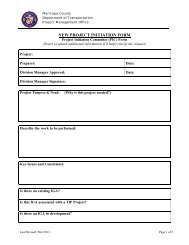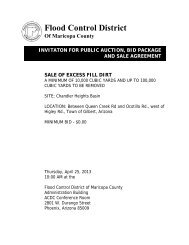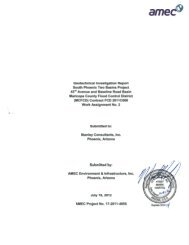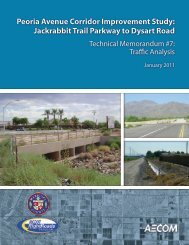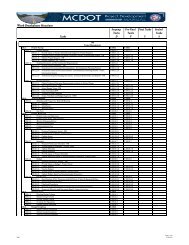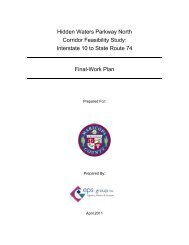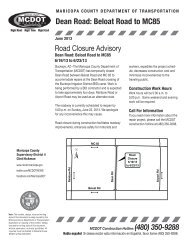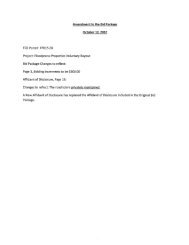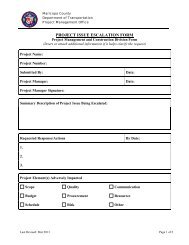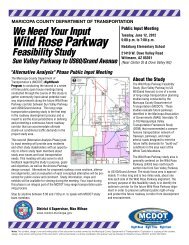Drainage Overview - Maricopa County Department of Transportation
Drainage Overview - Maricopa County Department of Transportation
Drainage Overview - Maricopa County Department of Transportation
You also want an ePaper? Increase the reach of your titles
YUMPU automatically turns print PDFs into web optimized ePapers that Google loves.
The crossings near 5 West Wash also deserve further attention when developing alignment<br />
alternatives because two tributaries join 5 West Wash near the Deer Valley Road alignment.<br />
Wash 1 confluences with 5 West Wash from the northeast and an unnamed tributary<br />
confluences with 5 West Wash from the south. Additionally, 5 West Wash is roughly<br />
parallel to the Deer Valley Road alignment for approximately 4,000 feet. All three washes<br />
have regulatory floodplains delineated. The combined floodplain width is approximately<br />
6,000 feet along the Deer Valley Road alignment. Significant coordination with FCDMC<br />
and FEMA may be needed because <strong>of</strong> the large extents <strong>of</strong> the regulatory floodplains, the<br />
proximity to the Deer Valley Road alignment, and the distributary nature <strong>of</strong> upstream<br />
flowpaths. For example, two dimensional modeling <strong>of</strong> the watershed may result in a more<br />
refined delineation <strong>of</strong> flood hazards, allowing for smaller drainage crossings.<br />
According to the Wittmann Area <strong>Drainage</strong> Master Study Update (ADMSU) Geomorphic<br />
and Sedimentation Analysis Report (FCDMC, 2005), there are locations within the study<br />
area that may require two-dimensional modeling. Typically these are flat areas with either<br />
braided channels or where no distinct channel is present. The soils in these areas are<br />
generally associated with active alluvial fans or alluvial plains. A map showing the location<br />
<strong>of</strong> the possible two-dimensional modeling areas has been included in Appendix TM3-08.<br />
3.4.2 Geologic Flood Hazards<br />
Flood hazard zones were defined for portions <strong>of</strong> the study area west <strong>of</strong> Trilby Wash in<br />
Geologic Mapping <strong>of</strong> Flood Hazards in Arizona: An Example from the White Tank<br />
Mountains Area, <strong>Maricopa</strong> <strong>County</strong> (1992). Excerpts <strong>of</strong> the mapping have been reproduced<br />
with regulatory floodplains and project boundaries overlaid on the AZGS flood hazard<br />
zones in Appendix TM3-06. Most areas within the study area are classified as areas <strong>of</strong> high<br />
flood potential, H2, which occurs in extensive young deposits where channels are small or<br />
nonexistent. The flooding in these areas is predominantly shallow sheet-flooding, with<br />
broad areas inundated in large flood events. The highest hazard zone, H1, occurs in<br />
extensive young deposits with a distributary channel system. Within the study area, small<br />
localized areas near the CAP were mapped as H1 hazard zones. Typically, proposed<br />
roadway alignments should avoid H1 flood hazard zones when possible. This designation<br />
indicates either an entrenched major drainage or a distributary flow area with potentially<br />
high flow velocities. Mitigation measures that include structural improvements built in<br />
these areas would likely need to be sized for large capacities and have increased<br />
maintenance needs.<br />
3.4.3 Alluvial Fans<br />
Active and inactive alluvial fan systems are located in the study area. These alluvial fans<br />
are sloping, fan-shaped landforms created over long periods <strong>of</strong> time by the transport and<br />
deposition <strong>of</strong> sediment as flows from the White Tank Mountains spread out. The alluvial<br />
fans in this area have been studied in detail as part <strong>of</strong> the Sun Valley Area <strong>Drainage</strong> Master<br />
Plan (SVADMP). The information presented in this section has been taken from the<br />
SVADMP Step 3 Recommended Alternative Report, the CAP Sub-Area (Volume 2)<br />
(FCDMC, 2006). Known problems associated with alluvial fan flooding include spatial<br />
uncertainty <strong>of</strong> water and sediment flow distribution, lack <strong>of</strong> containment within the<br />
relatively flat topographic relief laterally across the fan, avulsive movement <strong>of</strong> defined flow<br />
paths, distributary flow, sheet flooding, scour, and landform aggradation. Relatively steep<br />
091337137, 2011-018, TT005 <strong>Maricopa</strong> <strong>County</strong> <strong>Department</strong> <strong>of</strong> <strong>Transportation</strong><br />
Technical Memorandum 3 Deer Valley Parkway Feasibility Study<br />
<strong>Drainage</strong> <strong>Overview</strong> 14 April 2012





